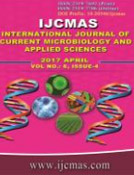


 National Academy of Agricultural Sciences (NAAS)
National Academy of Agricultural Sciences (NAAS)

|
PRINT ISSN : 2319-7692
Online ISSN : 2319-7706 Issues : 12 per year Publisher : Excellent Publishers Email : editorijcmas@gmail.com / submit@ijcmas.com Editor-in-chief: Dr.M.Prakash Index Copernicus ICV 2018: 95.39 NAAS RATING 2020: 5.38 |
One of the recent innovations in the field of agriculture is Pink Farming. It is a ex-situ farming technique using pink colored illumination for the cultivation of crops. This pink-colored light is a mixture of red and blue lights from LEDs (Light Emitting Diodes). are being converted into vertical pink farms are made by transformation of large warehouses located in the suburbs of the cities, growing crops arranged in shelves, top to bottom, one over other. Japan has the World’s biggest indoor vertical pink farm, Mirai Co. is situated at Japan. Visible light spectrum (V-I-B-G-Y-O-R) is constituted of seven different colors of different wavelengths. However, plant photosynthetic machinery absorbs wavelengths of red (630 nm – 750 nm) and blue light (450 nm -490 nm) efficiently. Since, red light promotes plant elongation and blue light enhances metabolites in crops. LEDs used in the pink-houses are cooler than the HPS (High – Pressure Sodium) lamps used in greenhouses, so they can be placed in the vicinity of plants. They have low power consumption, high brightness and nominal heat generation. Parameters such as water level, CO2 level, nutrient level, lighting, temperature and humidity can be precisely controlled in a vertical pink-house. Pink-houses can cultivate nutrient – dense, seasonal crops as well as medicinal plants all year round. A pink-house shows 20% faster growth rates in plants and 75% less energy consumption as compared to a greenhouse. Plants in a pink-house do not require sunlight or natural rainfall and are grown without the use of chemical fertilizers or pesticides.
 |
 |
 |
 |
 |